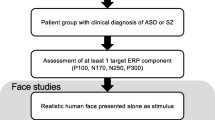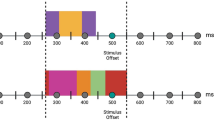Abstract
Autism spectrum disorder (ASD) is more common in males than females. An underrepresentation of females in the ASD literature has led to limited knowledge of differences in social function across the sexes. Investigations of face perception represent a promising target for understanding variability in social functioning between males and females. The current study analyzed electrophysiological brain recordings during face perception to investigate sex differences in the neural correlates of face perception and their relationship to social function. Event related potentials (ERP) were recorded from children with ASD while viewing faces, inverted faces, and houses. Relative to males, females showed attenuated response at an ERP marker of face perception, the N170. Among females, but not males, atypical face response was associated with symptom severity. Observed sex differences reflect influential differences in social information processing, and impairment in these features correlates with deficits in social information processing in females, but not males, with ASD. These findings hold significance for future treatment protocols, which should account for differences in males and females with ASD in clinical presentation and neural phenotypes.




Similar content being viewed by others
References
American Psychiatric Association. (2000). Diagnostic and statistical manual of mental disorders: DSM-IV-TR (4th ed.). Washington, DC: American Psychiatric Association.
Baio, J. (2012). Prevalence of autism spectrum disorders: Autism and developmental disabilities monitoring network, 14 Sites, United States, 2008. Morbidity and mortality weekly report. Surveillance Summaries, 61(3), 0738–1546.
Bauer, D., Goldfield, B., & Reznick, S. (2002). Alternative approaches to analyzing individual differences in the rate of early vocabulary development. Applied Psycholinguistics, 23(3), 313–335.
Bentin, S., Allison, T., Puce, A., Perez, E., & McCarthy, G. (1996). Electrophysiological studies of face perception in humans. Journal of Cognitive Neuroscience, 8(6), 551–565.
Benton, A., Sivan, A., Hamsher, K., Varney, N., & Spreen, O. (1994). Contributions to neuropsychological assessment. New York: Oxford University Press.
Bryson, S., & Smith, I. (1998). Epidemiology of autism: Prevalence, associated characteristics, and implications for research and service delivery. Mental Retardation and Developmental Disabilities Research Reviews, 4(2), 97–103.
Cahill, L. (2006). Why sex matters in neuroscience. Nature Reviews Neuroscience, 7, 477–484.
Carter, A., Black, D., Tewani, S., Connolly, C., Kadlec, M., & Tager-Flusberg, H. (2007). Sex differences in toddlers with autism spectrum disorders. Journal of Autism and Developmental Disorders, 37, 86–97.
Eisenberg, N., & Lennon, R. (1983). Sex differences in empathy and related capacities. Psychological Bulletin, 94(1), 100–131.
Elliott, C. D. (2007). Differential Ability Scales: Second edition (DAS-II). San Antonio, TX: Psychological Corporation.
Elsabbagh, M., Mercure, E., Hudry, K., Chandler, S., Pasco, G., Charman, T., et al. (2012). Infant neural sensitivity to dynamic eye gaze is associated with later emerging autism. Current Biology, 22(4), 338–342.
Fombonne, E. (2003). Epidemiological surveys of autism and other pervasive developmental disorders: An update. Journal of Autism and Developmental Disorders, 33(4), 365–382.
Gadow, K., & Sprafkin, J. (1994). Child symptom inventories manual. Stony Brook, NY: Checkmate Plus.
Happé, F. (1995). The role of age and verbal ability in the theory of mind task performance of subjects with autism. Society for Research in Child Development, 66, 843–855.
Hartley, S., & Sikora, D. (2009). Sex differences in autism spectrum disorder: An examination of developmental functioning, autistic symptoms, and coexisting behavior problems in toddlers. Journal of Autism and Developmental Disorders, 39, 1715–1722.
Herlitz, A., & Rehnman, J. (2008). Sex differences in episodic memory. Current Directions in Psychological Science, 17(1), 52–56.
Holtmann, M., Bolte, S., & Poustka, F. (2007). Autism spectrum disorders: Sex differences in autistic behaviour domains and coexisting psychopathology. Developmental Medicine and Child Neurology, 49, 361–366.
Huttenlocher, J., Haight, W., Bryk, A., Seltzer, M., & Lyons, T. (1991). Early vocabulary growth: Relation to language input and gender. Developmental Psychology, 27(2), 236–248.
Itier, R. J., & Taylor, M. J. (2002). Inversion and contrast polarity reversal affect both encoding and recognition processes of unfamiliar faces: A repetition study using ERPs. Neuroimage, 15(2), 353–372.
Joliffe, T., & Baron-Cohen, S. (1997). Are people with autism and Asperger syndrome faster than normal on the embedded figures test? Journal of Child Psychology and Psychiatry, 38(5), 527–534.
Kansaku, K., Yamaura, A., & Kitazawa, S. (2000). Sex differences in lateralization revealed in the posterior language areas. Cerebral Cortex, 10, 866–872.
Kanwisher, N., McDermott, J., & Chun, M. M. (1997). The fusiform face area: A module in human extrastriate cortex specialized for face perception. Journal of Neuroscience, 17(11), 4302–4311.
Key, A., & Stone, W. (2012). Same but different: 9-month-old infants at average and high risk for autism look at the same facial features but process them using different brain mechanisms. Autism Research, 5(4), 253–266.
Koenig, K., & Tsatanis, K. (2005). Pervasive developmental disorders in girls. In D. Bell, E. Foster, & E. Mash (Eds.), Behavioral and emotional problems in girls. New York: Kluwer Academic/Plenum Publishers.
Lai, M., Lombardo, M., Pasco, G., Ruigrok, A., Wheelwright, S., Sadek, S., et al. (2011). A behavioral comparison of male and female adults with high functioning autism spectrum conditions. PLoS ONE, 6, e20835.
Lang-Takac, E., & Osterweil, Z. (1992). Separateness and connectedness: Differences between the genders. Sex Roles, 27(5/6), 277–289.
Leeb, R., & Rejskind, G. (2004). Here’s looking at you, kid! A longitudinal study of perceived gender differences in mutual gaze behavior in young infants. Sex Roles, 50(1/2), 1–14.
Lord, C., Risi, S., Lambrecht, L., Cook, E. H., Jr, Leventhal, B. L., DiLavore, P. C., et al. (2000). The autism diagnostic observation schedule-generic: A standard measure of social and communication deficits associated with the spectrum of autism. Journal of Autism and Developmental Disorders, 30(3), 205–223.
Lord, C., Rutter, M., & Le Couteur, A. (1994). Autism diagnostic interview-revised: A revised version of a diagnostic interview for caregivers of individuals with possible pervasive developmental disorders. Journal of Autism and Developmental Disorders, 24(5), 659–685.
Lord, C., & Schopler, E. (1985). Brief report: Differences in sex ratios in autism as a function of measured intelligence. Journal of Autism and Developmental Disorders, 15(2), 185–193.
Lord, C., Schopler, E., & Revicki, D. (1982). Sex differences in autism. Journal of Autism and Developmental Disorders, 12(4), 317–330.
Lutchmaya, S., & Baron-Cohen, S. (2002). Human sex differences in social and non-social looking preferences, at 12 months of age. Infant Behavior and Development, 25, 319–325.
Mandy, W., Chilvers, R., Chowdhury, U., Salter, G., Seigal, A., & Skuse, D. (2011). Sex differences in autism spectrum disorder: Evidence from a large sample of children and adolescents. Journal of Autism and Developmental Disorders, 42(7), 1304–1313.
McLennan, J., Lord, C., & Schopler, E. (1993). Sex differences in higher functioning people with autism. Journal of Autism and Developmental Disorders, 23(2), 217–227.
McMahon, W., & Ritvo, A. (1989). The UCLA-University of Utah epidemiologic survey of autism: Prevalence. American Journal of Psychiatry, 146, 194–199.
McPartland, J., Cheung, C. H., Perszyk, D., & Mayes, L. C. (2010). Face-related ERPs are modulated by point of gaze. Neuropsychologia, 48(12), 3657–3660.
McPartland, J., Dawson, G., Webb, S. J., Panagiotides, H., & Carver, L. J. (2004). Event-related brain potentials reveal anomalies in temporal processing of faces in autism spectrum disorder. Journal of Child Psychology and Psychiatry, 45(7), 1235–1245. doi:10.1111/j.1469-7610.2004.00318.x.
McPartland, J. C., Wu, J., Bailey, C. A., Mayes, L. C., Schultz, R. T., & Klin, A. (2011). Atypical neural specialization for social percepts in autism spectrum disorder. Social Neuroscience, 6(5–6), 436–451. doi:10.1080/17470919.2011.586880.
Moore, T. (1967). Language and intelligence: A longitudinal study of the first eight years. Human Development, 10(2), 86–106.
O’Connor, K., Hamm, J. P., & Kirk, I. J. (2005). The neurophysiological correlates of face processing in adults and children with Asperger’s syndrome. Brain and Cognition, 59, 82–95.
Pavlova, M., Guerreschi, M., Lutzenberger, W., Sokolov, A., & Krageloh-Mann, I. (2012). Cortical response to social interaction is affected by gender. Neuroimage, 50, 1327–1332.
Piefke, M., Weiss, P., Markowitsch, H., & Fink, G. (2005). Gender differences in the functional neuroanatomy of emotional episodic autobiographical memory. Human Brain Map**, 24(4), 313–324.
Proverbio, A., Brignone, V., Matarazzo, S., Del Zotto, M., & Zani, A. (2006). Gender differences in hemispheric asymmetry for face processing. BMC Neuroscience, 7(1), 44.
Pugh, K., Shaywitz, B., Shaywitz, S., Constable, T., Skudlarski, P., Fulbright, R., et al. (1996). Cerebral organization of component processes in reading. Brain, 119, 1221–1238.
Rossion, B., Campanella, S., Gomez, C., Delinte, A., Debatisse, D., Liard, L., et al. (1999). Task modulation of brain activity related to familiar and unfamiliar face processing: An ERP study. Clinical Neurophysiology, 110, 449–462.
Schneider, W., Eschman, A., & Zuccolotto, A. (2002). E-prime user’s guide. Pittsburg: Psychology Software Tools Inc.
Scott, F., Baron-Cohen, S., Bolton, P., & Brayne, C. (2002). Brief report: Prevalence of autism spectrum conditions in children aged 5–11 years in Cambridgeshire, UK. Autism, 6(3), 231–237.
Sparrow, S., Cicchetti, D., & Balla, D. (2005). Vineland Adaptive Behavior Scales (2nd ed.). Bloomington: Pearson.
Taylor, M. J., Batty, M., & Itier, R. J. (2004). The faces of development: A review of early face processing over childhood. Journal of Cognitive Neuroscience, 16(8), 1426–1442.
Tsai, L. Y., & Beisler, J. M. (1983). The development of sex differences in infantile autism. The British Journal of Psychiatry, 142(4), 373–378.
Tucker, D. (1993). Spatial sampling of head electrical fields: The geodesic sensor net. Electroencephalography and Clinical Neurophysiology, 87(3), 154–163.
Volkmar, F., Szatmari, P., & Sparrow, S. (1993). Sex differences in pervasive developmental disorders. Journal of Autism and Developmental Disorders, 23(4), 579–591.
Wechsler, D. (1997). Manual for the Wechsler Adult Intelligence Scale (3rd ed.). San Antonio, TX: The Psychological Corporation.
Wing, L. (1981). Sex ratios in early childhood autism and related conditions. Psychiatry Research, 5, 129–137.
Yeargin-Allsopp, M., Rice, C., Karapurkar, T., Doernberg, N., Boyle, C., & Murphy, C. (2003). Prevalence of autism in a US metropolitan area. The Journal of the American Medical Association, 289(1), 49–55.
Acknowledgments
This research was supported by NIMH R03 MH079908, NICHD PO1HD003008, CTSA Grant Number UL1 RR024139, NIMH K23MH086785, NARSAD Atherton Young Investigator Award, NIMH R21 MH091309, NIMH R01 MH100173 and R01 MH100028. Its contents are solely the responsibility of the authors and do not necessarily represent the official view of the NIH. We gratefully acknowledge the contributions of the funding sources that made this research possible, the parents and children who participated in this study, and several other people who made significant contributions to this research, including Linda Mayes, Robert Schultz, Ami Klin, Danielle Perszyk, Cora Mukerji, Jeffrey Eilbott, Jia Wu, Kevin Pelphrey, and Christopher Bailey.
Author information
Authors and Affiliations
Corresponding author
Rights and permissions
About this article
Cite this article
Coffman, M.C., Anderson, L.C., Naples, A.J. et al. Sex Differences in Social Perception in Children with ASD. J Autism Dev Disord 45, 589–599 (2015). https://doi.org/10.1007/s10803-013-2006-5
Published:
Issue Date:
DOI: https://doi.org/10.1007/s10803-013-2006-5




